4—
Performance Style and the Interaction of Signifying Practices
Theoretical Approach to the Interaction of Signifying Practices
Though a simple model of linear causality cannot adequately explain the transformation in cinematic performance style, a transformation in one signifying practice, narrative, crucially inflects performance in the Biographs. To elucidate this connection, I shall in this section present a model that theorizes the interaction among performance, narrative structure, and character-centered signifiers. Signifying practices refers to overall systems of meaning, such as editing, lighting, and camera work. Signifier refers to a particular element of a signifying practice, such as a jump cut, low-key lighting, or a tracking shot. While narrative is a signifying practice, it is clearly of a different order and may to some extent be considered a result of the cumulative effect of the other signifying practices or, in other words, a result of the interaction of signifying processes including performance.
During the years in which performance style changed from histrionically to verisimilarly coded, a concomitant change occurred in narrative structure, from "pure melodrama" to a degree of psychological realism resembling that of nineteenth-century literary and dramatic realism.[1] The "pure melodrama" relied on non-psychological causality as the mainspring of the narrative, while the "realist" narrative depended on character psychology. I quote David Bordwell about the role of character psychology in the classical Hollywood cinema; the "premise of Hollywood story construction," Bordwell says, is
causality, consequence, psychological motivations, the drive toward overcoming obstacles and achieving goals. Character centered—i.e., personal or psychological—causality is the armature of the classical story.
This sounds so obvious that we need to remember that narrative causality could be impersonal as well. Natural causes (floods, genetic inheritance) could from the basis for story action.[2]
Floods and other natural causes—Acts of God—did indeed provide the narrative causality for many a melodrama. In the "realist" narrative, however, psychological causality structures the narrative and, hence, the deployment of signifying practices: "Psychological causality, presented through defined characters acting to achieve announced goals, gives the classical film its characteristic progression."[3]
Clearly, the distinction between nonpsychological and psychological causality is relative rather than absolute: no film will conform entirely to either category. But the distinction remains useful for heuristic purposes, particularly given that we have already established the strong connection between the emergence of the verisimilar code in the theatre and the emphasis on the construction of individualized rather than stock characters.
What was the relationship between character and narrative in the melodrama, and how does it differ from that in the classical Hollywood style? What might the implications of these different relationships be for the deployment of other signifying practices? The Russian formalist Sergei Balukhatyi looked at the nineteenth-century French melodrama from a structuralist perspective, in the process furnishing an analysis of melodramatic character, as suggested in this excerpt from Daniel Gerould's paraphrased translation:
Characters in melodrama do not carry the full weight of real life; they are rather only outlined distinctly, being effective not in themselves, but as . . . points of attachment for the springs of the plot. Above all, characters in melodrama are devoid of individuality, either personal or everyday realistic; they are interesting to the spectator not . . . because of their . . . psychic substance, as are the characters in realistic, psychological drama, but only because of their role in interweaving plotline, their creation of dramatic situations.[4]
Can structuralist literary theory furnish any help in evaluating the validity of Balukhatyi's distinction between melodrama and the "realistic, psychological drama"?[5] Unfortunately for this purpose, structuralists such as A. J. Greimas and Vladimir Propp have tended to reduce character to a function of narrative, while ignoring the psychological characters of nineteenth-century realism. As Jonathan Culler says, "Character is the major aspect of the novel to which structuralism has paid the least attention and been the least successful in treating."[6] Most structuralists would reject Henry James's conflation of character and incident. Tzvetan Todorov, however, seriously, albeit briefly,
reflects upon James's queries, contrasting narratives in which "everything is subservient to the psychology of the characters" to those in which "the characters are subservient to the action."[7] Todorov makes the distinction not through character analysis but by looking at the causal structure of the narrative:
We might speak of an immediate causality as opposed to a mediated causality . The first would be of the type "X is brave—X challenges the monster." In the second, the appearance of the first proposition would have no immediate consequence, but in the course of the narrative X would appear as someone who acted bravely. This is a diffused, discontinuous causality, which is expressed not by a single action but by secondary aspects of a series of actions, often remote from one another.
Todorov chooses an example from The Arabian Nights to illustrate immediate causality: "Sinbad likes to travel (character trait)—Sinbad takes a trip (action)."[8] A narrative of "diffused, discontinuous causality" would motivate Sinbad through prior establishment of his love of travel, perhaps attributing his wanderlust to a stultifying youth spent on a Kansas farm during which he never ventured further than the general store in the nearest small town. A narrative of immediate causality dispenses with such niceties. Sinbad likes to travel because he likes to travel—because, that is, the narrative requires that he likes to travel. In the nonpsychological narrative of immediate causality, characters do not motivate the narrative; the narrative motivates the characters. As Seymour Chatman summarizes Todorov's argument: "the characters are deprived of choice and become . . . mere automatic functions of the plot."[9]
As Chatman suggests, to further differentiate the nonpsychological from the psychological narrative we must ask whether and to what degree the characters seem to control their own destinies. In the former, characters respond willy-nilly to external forces: fate, fortune, natural disasters, and so on. In the latter, they respond to their own (often contradictory) desires and emotions: love, hate, greed, etc. Self-doubt never disturbs the blackly evil or shiningly virtuous stock figures of the melodrama. To adopt Robert Heilman's terminology, they are whole rather than divided characters.[10] With no internal conflict and thus no internal motivation, external forces must create the necessary narrative disequilibrium. This is why, in the "pure melodrama," the characters often find themselves at the mercy of fate, which batters them for four acts and miraculously saves them in the fifth. As James L. Smith maintains, "It is this total dependence upon external adversaries which finally separates melodrama from all other serious dramatic forms."[11]
As we have seen, then, the relationship between character and narrative in the "pure melodrama" involves immediate causality and external motivation, while nineteenth-century realist literature and the Hollywood style derived from it involve mediated causality and internal motivation. Psychological
filmic narratives driven by mediated causality and internal motivation, in which performance is generally verisimilarly coded, deploy signifying practices differently from nonpsychological narratives driven by immediate causality and external motivation, in which performance is generally histrionically coded. In the classical Hollywood style filmmakers reveal thoughts and emotions by selecting and combining signifiers from paradigms of equivalent signifiers. The actor's performance is only one among several signifiers revealing a character's mental processes. In the Biographs (and other films of this period) that resembled the "pure melodrama," performance alone often had to convey all the information about a character's thoughts and emotions necessary for audience comprehension of the narrative.
Because the histrionic code more nearly resembles spoken language than does the verisimilar code, an unaided histrionically coded performance can convey a great deal of narrative information. Barthes asserts that nonverbal sign systems are almost always translated into articulated speech: "Is not speech the inevitable relay of any signifying order. . . . Man is doomed to articulated language."[12] The histrionic code's resemblance to articulated speech facilitates this translation. But with the move to psychological causality the histrionic code became increasingly inadequate, its reliance upon standardized gestures making it unsuitable for the portrayal of individualized, psychologized characters.
The verisimilar code abandoned the conventional gestures, replacing them with gestures coded by cultural expectations about how particular characters in particular situations might behave in real life. Tailoring gestures and expressions to an individual character, the verisimilar code contributed to the creation of credibly psychologized individuals, in the process helping to forge the inextricable link between character and narrative of the classical style. To quote Bordwell again: "If characters are to become agents of causality, their traits must be affirmed in speech and physical behavior, the observable projections of personality."[13]
Nonetheless, admirably suited as it was to psychological causality, the verisimilar code's lack of resemblance to natural language hampers its translation to articulated speech and hence its ability to convey sufficient information in the absence of other signifiers. As Barthes tells us:
an image inevitably involves several levels of perception, and the reader of the image has at his disposal a certain freedom . . . every glance at an image inevitably implies a decision; i.e., the meaning of an image is never certain. . . . The image freezes an endless number of possibilities; words determine a single certainty.[14]
The possibility of multiple interpretations of an actor's expressions and gestures gave rise to an unwelcome polysemy, posing problems of narrative clarity. In 1911, a writer in The Moving Picture World complained about the failure of the verisimilar code to pin down an unambiguous meaning.
Nothing that is not clear and plain as daylight will be wholly effective as drama. . . . The pantomime actor can picture the emotion perfectly; the audience will see it and sympathize, but like one who sees another man in grief and doesn't know why he looks so sad; it can guess the reason but guessing isn't knowing.[15]
Though an avid partisan of the new style, even Frank Woods of The New York Dramatic Mirror realized that performance might "improve" at the expense of narrative clarity. In 1909 he said, "The whole problem . . . is one of approximating reality and at the same time making the story clear."[16]
As does the caption of a photograph, the addition of other signifiers closes off the "endless number of possibilities," giving the acting the precise meaning necessary to the flow of a coherent narrative. Consider the Kuleshov experiment, in which the actor's expression by itself meant nothing and yet, in concert with other signifiers, was thought to externalize immediately identifiable emotions.[17] Verisimilarly coded performance imparts information about a character's thoughts and emotions in conjunction with other signifiers. Those signifiers that work in conjunction with performance, aiding in the revelation of a character's thoughts and emotions, I shall refer to as character-centered .
A brief discussion of filmic narrators may help to clarify the concept of character-centered signifiers. In "Genette and Film: Narrative Level in the Fiction Cinema," David Black addresses the question of narrative level in films with voice-over narration, using Genette to elucidate the problems of authorial agency that such films pose. Referring to the character Walter Neff, in Double Indemnity (Billy Wilder, 1944), Black says; "Diegetically, he is posited as the narrating agent responsible for the story; in fact his claim to that position is challenged by no less a pretender than the narrative agency of the film itself (to which he as a character owes his existence), with all its recourse to extra- and non-verbal devices."[18] Black refuses to ascribe this agency to characters, directors, writers, or the camera, but rather labels it the "intrinsic narrator . . . whose narrative agency is congruent with the discursive activity of the medium itself."[19] Thus, while characters may occasionally seem to authorize the diegesis, they are always subordinate to the intrinsic narrator, which at times only seems to relinquish its authorial authority to varying degrees.
In general then, those signifiers over which the intrinsic narrator seems to grant the character some control are the most character-centered. In other words, character-centered signifiers seem to be authorized by the characters rather than by the intrinsic narrator, with the degree of seeming authorization varying from signifier to signifier. For example, a tracking shot that follows character movement seems, to some degree, to be character-authorized while a point-of-view shot has a higher degree of character-authorization. This determination of character authorization admittedly involves close calls at the
plate, but unlike the umpire, we are aided by numerous replays of the players' actions.[20]
The Interaction of Signifying Practices in the Biographs
As suggested above, the transformation of performance style is inextricably linked with the shift from the pure melodrama to the realist psychological narrative. Though the Biographs can more readily be assigned to the melodrama than to any other genre, not all Biographs, and perhaps no single Biograph, would meet all the criteria of "pure melodrama," for melodrama is not a static genre but, like all genres, is subject to change over time. By 1913 most Biographs differed from the "pure melodrama" by substituting psychological causality for coincidence and psychologized individuals for stock figures, yet they still resembled the melodrama more closely in many respects than the classic nineteenth-century realist novel and drama from which the psychological causality of the classical Hollywood style derived. Two Biographs from 1909 located along the range from pure melodrama to psychological realism illustrate the workings of the interaction of performance, narrative, and character-centered signifiers.
The Rocky Road , released January 3, 1910, closely resembles the pure melodrama and indeed descends from the popular temperance melodrama. The Biograph Bulletin publicity even references the film's antecedents by foregrounding its nonpsychological narrative causality. The promotional copy is subheaded "A Story of Fate's Capriciousness," and the blurb elaborates on this theme, almost apologizing for the film's melodramatic reliance upon fate and coincidence: "Coincident as the episodes may appear they are evolved with a convincing consistency rarely found in dramatic stories of this type."[21]
The film, like A Drunkard's Reformation and Brutality , shows the miseries that a husband's drunkenness brings on his family. As the film begins, the husband (Frank Powell) carouses in a saloon with his companions, then returns home to abuse his wife (Stephanie Longfellow), who is caring for their sick daughter (Edith Haldeman). The man deserts his wife, who goes mad and roams the streets carrying the child and looking for her husband. She encounters a peddler who gives her a cloak for the daughter and, after further wandering, collapses in a haystack. Thinking she hears her husband, she abandons the child, who is found and adopted by a kindly farm family. The wife, suffering from amnesia, becomes a maid to another kindly family in the same neighborhood. Meanwhile, the husband, as an intertitle puts it, "gets work in a distant village and resolves to brace up." Another intertitle announces "Later. The Husband Favored by Fortune," and we see the husband quitting his job as a laborer and driving off in a chauffeured limousine that breaks down outside the house where his daughter (by now, Blanche Sweet) is celebrating
her eighteenth birthday. After a couple of meetings the father proposes to his daughter, but before the wedding day a chance encounter with her husband causes the wife's memory to return. On the wedding day itself, the wife passes her daughter's home, sees her husband drive off to his wedding, and staggers to the door, where a friendly maid (Kate Bruce) lets her in. Sitting at the table she sees a picture of her husband and learns he is about to be married. The maid tells the story of the bride's adoption, producing the cloak the peddler had given the mother years before. The horrible enormity of her knowledge full upon her, the mother rushes to the church just in time to prevent the ceremony. After "The Terrible Revelation" (as an intertitle puts it), she collapses into her husband's arms while the wedding guests look away and the minister raises an arm to heaven, the company forming a tableau.
The narrative of The Rocky Road endows the main characters, the husband and wife, with single character traits that lead to immediate action. The husband drinks. He abuses and deserts his wife. The wife goes mad. She abandons her child. The husband resolves to brace up. He gets a job. The factors that might have contributed to the husband's drunkenness and subsequent reformation or the wife's madness and sudden cure are simply irrelevant. The film does not tell us about the husband's miserable childhood or the wife's previous history of mental instability. Instead, fate and implausible coincidence motivate the characters. Two kind-hearted families in the same neighborhood fortuitously shelter both mother and child. The husband, having been favored by fortune, is fortuitously stranded on his daughter's doorstep. The wife fortuitously sees her husband before the wedding day and passes her daughter's house on the day itself. In the nick of time, the old cloak leads the mother to her appalling realization—articles of clothing, along with birthmarks and lockets, being the staple melodramatic devices for identifying long-lost children.
His Lost Love was released on October 16, 1909, a few months earlier than The Rocky Road , but despite its earlier date this film much more closely resembles the realist, psychological narrative, indicating that there was certainly no inevitable progression toward the classical Hollywood style. In the Biograph Bulletin publicity for His Lost Love a subheading beneath the film title focuses on human causality: "A Brother's Sacrifice and Its Outcome." The copy refers to the film's reliance on internal motivation, speaking of the "struggle against self" of two of the characters.[22]
The film involves the romantic attachments and misalliances of two brothers (James Kirkwood and Owen Moore) who are both attracted to Mary Pickford. Although Kirkwood loves Pickford he selflessly renounces her after she and Moore fall in love. They are married, Pickford's sister (Marion Leonard) comes to visit, and a mutual attraction grows between Leonard and Moore. An intertitle, "The Old Struggle Against Self," precedes a scene in which Moore struggles to remain faithful to his wife but gives way to temptation.
After Pickford has a baby, the sister attempts to leave, but her farewell to Moore is observed by Pickford. Moore and Leonard go off together, leaving Pickford collapsed in Kirkwood's arms. After her inevitable death, Kirkwood vows to raise the child.
Contrast the intertitle "The Old Struggle Against Self" with "Later. The Husband Favored by Fortune" of The Rocky Road . In His Lost Love all four characters to some extent control the course of their futures. Pickford rejects Kirkwood for Moore. Kirkwood renounces Pickford and later adopts her baby. Moore wavers between honor and dishonor. Leonard flirts with the husband but then decides on the honorable course. At this point, fate intervenes with Pickford's accidental witnessing of her sister's departure precipitating her death. Just as the motivation is largely internal, causality is mediated. Kirkwood adopts the child at the end of the film because he loved the mother at the beginning.
These two films allow us to explore the correlation among performance, psychological causality, and character-centered signifiers while holding relatively constant the factor of chronology. If the hypotheses about the interaction of signifying practices are correct, there should be noticeable differences in performance style and the deployment of signifiers even though the films were made only a few months apart. The differences are indeed striking. The unchecked histrionic code is employed throughout most of The Rocky Road , while the performers in His Lost Love employ a mixture of the verisimilar and checked histrionic codes, resorting to the unchecked histrionic code only in one climatic shot. The Rocky Road contains gestural soliloquies in which performers externalize the same intense emotion through the repeated gestures of the unchecked histrionic code, unaided by character-centered signifiers, but in His Lost Love , decision-making and thought processes are externalized through performance, props, and editing.
Close analysis of a few shots from each film, starting with the gestural soliloquies of The Rocky Road , makes clear the contrast. In shot 4, the husband stands outside his house, making his decision to abandon his family. He smiles, raises his fingers in the air in an "I have an idea!" gesture, indicates the house, with thumb over shoulder, moves his hand as if pushing the house away, raises his hand to his ear, and brings it down to his side in resolution, then clenches his fists in the air. After a cut to the interior, shot 6 shows the mother outside the house. She enters the shot holding both arms raised level with her head, points left (in the direction the husband exited), clenches her fist, and reenters the house. Here both characters have reached decisions, but only the conventional gestures indicate this, for we are in no way privy to the thought processes leading up to the decision.
In shots 12, 13, and 22 we again see conventional gestures performed in unchecked fashion. In shot 12 the mother returns home from the saloon after looking for her husband. She enters the house, raises the back of her hand to
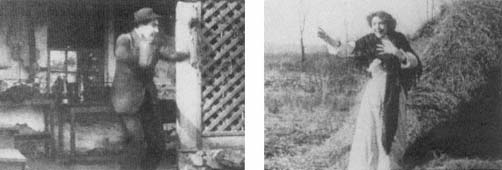
Left: The Rocky Road: "I have an idea!" Right: The Rocky Road: "I am distressed!"
her forehead, while her other hand is raised at her side. Taking the child with her, she exits into shot 13, the house's exterior, where she raises her hand to heaven, then points off left again. In shot 22 the conventional gestures are used in repeated series to portray the mother's anguish at the loss of her child. She returns to the haystack where she had left her child and, not finding her there, raises her left hand to her breast while her right hand is clenched at her side. She points with her left hand, moving her right hand to her breast, and then puts both hands on her breast. She reaches down to where the child was, puts her hands back on her breast, reaches down again, puts both hands back on her breast, and walks off. Throughout the shot, the actor has told us only one thing: "I am distressed."
In His Lost Love much of the information is conveyed by conversational gestures, glances, and byplay that are entirely absent from The Rocky Road . In the film's first shot, Kirkwood proposes to Pickford. Frank Powell, the father, sits rear left, and Pickford sits left of the central table. Kirkwood enters right and leans on the table near Pickford, while the father rises to stand behind them. Kirkwood gestures to himself, then to Pickford. She touches her chest tentatively as if to say "Me?" Kirkwood and Powell both hold their hands out to her in confirmation, then Pickford sits next to Kirkwood on the table. He holds her hand, kisses it, and looks up at her. She looks down bashfully, and they hug. In the third shot, Moore talks to Pickford, sitting next to her on the table and putting his hand over hers. Kirkwood reenters, places a hand on Moore's shoulder, and gestures offscreen, as if telling him he is wanted. Moore walks to the door and watches while Kirkwood takes Pickford's hand and then kisses her. Moore sneers, clenches his fist, and makes a small downward movement, giving a checked version of the conventional gesture of resolution. The glances and byplay combine with the conversational gestures to set up the triangle.
The title "The Old Struggle Against Self" precedes a five-shot sequence
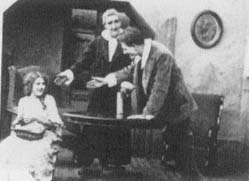
His Lost Love: Conversational gestures.
in which Moore is torn between fidelity and desire, the verisimilar code working in concert with props and editing (and the occasional conventional gesture) to illuminate his thought processes. In shot 7, set in Moore and Pickford's living room, Leonard stands at a table looking at a book (an important prop). Standing behind her, Moore raises his hands as if to embrace her, but Pickford enters with a nurse, looking weak. She sits, puts her hand on her stomach, and Moore crosses to her, pats her head, and holds her hand. Leonard gestures offscreen and walks to the door. Moore walks over to her and she asks a question. He looks to Pickford, then back to Leonard, and shakes his head. She leaves, and he remains in the doorway, looks at Pickford, shakes his head again, and clenches his fist and hits his thigh in a gesture of frustration. Then he walks to Pickford and picks up her knitting (another important prop). The ninth shot shows Pickford's sister in church, handing a note to an old man and sending him to fetch the music book she forgot. In shot 10 Pickford knits and Moore reads. The old man delivers the note, and Moore exits, about to take the book to his sister-in-law. Pickford stops him. Moore puts the book on the table and walks over to Pickford, who shows him the little garment she is knitting, lowering her head in embarrassment. Moore takes it from her, fingers it, and then sinks to one knee and rests his head on his forearm in a conventional remorseful pose. Pickford puts a hand on his shoulder, and Moore rises and kisses her. Standing with his hand on her shoulder, he makes a pushing-away gesture, a sort of negative wave, toward the door, which is associated with the sister. He then walks over to the table and leans on it, looking down at the book, which he finally picks up. After another cut to the sister in church, Moore reaches his decision. Still standing at the table holding the book, he looks up and right, away from Pickford, who is looking at him. Through conversational gestures he tells her he will deliver the book. At the door, he hes-
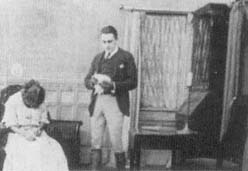
His Lost Love: Knitting as a prop.
itates, looks at Pickford and then at the book, and this time makes a negative wave at Pickford.
The conventional gestures of The Rocky Road indicate the characters' decisions, but the mixture of conventional gestures, glances, and byplay in His Lost Love makes the audience privy to the decision-making process: Moore changes his mind several times as he waffles between wife and sister-in-law. Yet without the props (book and knitting) and the editing (cutting to the sister in church), Moore could not so clearly reveal his character's mental processes.
In the climactic scene of His Lost Love we see the use of the histrionic code in the absence of other character-centered signifiers. In this shot, in which Pickford learns of her husband's betrayal and husband and sister-in-law leave together, all four performers use the unchecked histrionic code. Leonard and Moore stand in the entrance hall as she tells him she is leaving. With one hand on her breast, she uses her other hand to push against Moore's chest, points offscreen (indicating Pickford), then points to the door. Moore grabs her hands and kisses them, but she shakes her head. Pickford enters, clenches her hands on either side of her face, extends her arms, and sinks to the floor. Kirkwood enters, pushes Moore and Leonard apart, points at Pickford, and spreads his arms wide as if to ask, "What are you doing?" Leonard raises her hands in a "stop" gesture, puts her hands on her chest ("It's my fault"), extends her left hand backward ("I shall leave"). Moore takes her hand and points to his chest ("I'm going, too"). Kirkwood raises his hands in fury as Pickford, still on the floor, clutches at his jacket and pleads, until he lowers his hands to her shoulders. Moore and Leonard leave, Pickford reaches out in their direction, then collapses into Kirkwood's arms.
In looking at The Rocky Road and His Lost Love , we have controlled for chronology while investigating the relationship among performance, psychological causality, and character-centered signifiers. But chronology must also be accounted for. Hence we shall look at two Biographs, After Many Years ,
released in November 1908, and a June 1911 remake of the same subject, Enoch Arden , both based on Tennyson's narrative poem, "Enoch Arden."[23] Biograph did not use Tennyson's names for the characters in After Many Years , which the Bulletin described as "a subject on the lines of Enoch Arden, although more intensely heart stirring than the original story,"[24] but for clarity's sake I shall use Tennyson's names for the characters in both films.
In the films, Enoch Arden, a fisherman (Charles Inslee [1908], Wilfred Lucas [1911]), marries Annie Lee, his childhood sweetheart (Florence Lawrence [1908], Linda Arvidson (1911]), who chooses him over Philip Ray, another childhood friend (Harry Solter [1908], Frank Grandon [1911]). The couple have children, Enoch goes to sea, and he is shipwrecked on a desert island for ten years. Philip repeatedly proposes to Annie, who strives to remain true to Enoch. In After Many Years , she rejects Philip, while in Enoch Arden she accepts him for her children's sake. Finally, Enoch is rescued, in After Many Years returning to find that Annie has been faithful and in Enoch Arden to find that she has married Philip Lee and borne his child. In the earlier film, Enoch is joyously reunited with his family, while in the later film Enoch looks at Annie, Philip, and the children, vows Annie shall never know of his return, and conveniently dies.
The films were chosen because, of all the Biographs, they are the only pair of original and remake. Although Griffith often recycled themes, situations, and entire plots, Enoch Arden comes closest to the modern concept of the remake, in which the same characters enact a narrative similar to that of the original. Both films tell the same story, Enoch Arden restaging many scenes from After Many Years but using different signifiers to impart the same narrative information. Comparison of these scenes tests the hypothesis that the transition from the histrionic to the verisimilar codes entailed the increasing use of character-centered signifiers. While the plots are similar, differences in causality and motivation place After Many Years closer to the pure melodrama than Enoch Arden , allowing a test of the hypothesis that the verisimilar code is associated both with psychological narratives and character-centered signifiers. The later film, a two-reeler rather than the standard (for Biograph) one-reeler of the period, devotes the extra time to a prologue establishing the love triangle and to several scenes around Enoch's departure. Enoch Arden actually shows Annie rejecting Philip in favor of Enoch, a rejection reenacted each time that Philip proposes after Enoch's shipwreck. The prologue, by creating a "diffuse, discontinuous causality," strengthens the understanding of Annie's internal conflict and more strongly motivates her steadfastness than in After Many Years . Awareness of the love triangle also provides stronger motivation for Enoch's despair and Philip's persistence.
As "diffuse, discontinuous causality" strengthens internal motivation in Enoch Arden , immediate causality weakens internal motivation in After Many Years . In this film, Enoch leaves his wife with great reluctance, but seems to
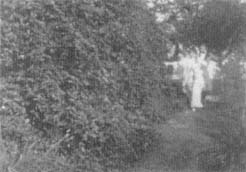
After Many Years : Enoch and Annie.
have no choice in the matter. Two sailors arrive, presumably to tell him that his ship is sailing. Enoch is a sailor—he must sail. In Enoch Arden the title character signs on for a voyage only after an agonized decision. Although both characters are shipwrecked by fate, the later Enoch at least has chosen to make the voyage. This choice invests his leave-taking scenes with far more poignancy, for there is always the possibility that he might change his mind.
The close analysis focuses upon seven scenes included in both films that employ different signifiers and in which the performers use different degrees of the histrionic and verisimilar codes. As a general rule, the fewer the character-centered signifiers, the more active the performance. We need to look at whether the text simply presents an actor's performance, thus requiring the actor to convey all the relevant information, or attempts to close off the meaning of the performance through character-centered signifiers.
1—
Introduction of the Characters
In Enoch Arden the verisimilar code and character-centered signifiers together give us far more specific information about Annie, Enoch, and Philip than we receive in After Many Years . In the first shot of the earlier film, Enoch and Annie walk together in a garden beside a large bush that runs the diagonal length of the frame. They have their arms spread wide as if to embrace the scenery, to which they gesture. Annie runs a little ahead, making the quick movements typical of youthful Griffith heroines. Enoch catches up with her, she points to the bush, picks a rose, puts it in Enoch's lapel, and the couple kisses twice. So far we know only that the couple is in love and, given intertextual knowledge of other Griffith films, that they are probably married since the heroine permitted two kisses. With the exception of the rose, the histrionically coded acting alone indicates the couple's love. Not until the next shot does the appearance of their baby confirm the couple's married status.
In Enoch Arden the first three shots introduce the three main characters and
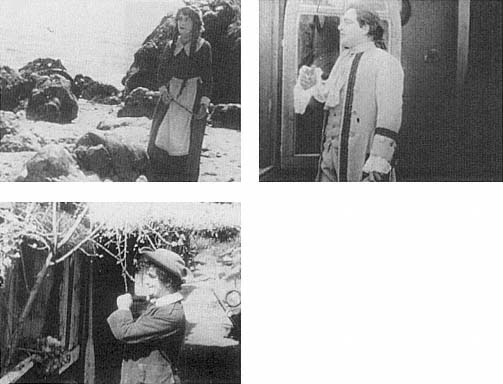
Above left: Enoch Arden : Annie.
Above right: Enoch Arden : Philip.
Lower left: Enoch Arden : Enoch.
instantly establish the love triangle. The first shot shows a rocky beach where much of the subsequent action takes place. Annie enters slowly, pensively tapping a stick against her hand, looks to the right, then sits on a rock, tracing patterns in the sand with the stick. In the second shot Philip stands at a window looking screen left. He has his right hand raised as if reaching out to somebody, presumably Annie, whom he sees through the window. He lowers his hand, puts on his hat, and exits. In the third shot Enoch stands in front of his house toying with a vine and looking left. With the exception of Philip's raised hand, the minimal gestures in these shots express the characters' general affect, but the props, editing, and direction of gazes tell the story. The slow, distracted fashion in which Annie and Enoch handle their props tell us they are thinking, but the intercutting and matching looks between Annie and Enoch tell us what they are thinking about.
The fourth shot unites the points of the triangle established by the first three shots. Enoch stands in the background, watching Annie and Philip talk. It is interesting to compare Enoch's reactions in this and the next shot. Standing in the back of the frame, Enoch does nothing but look at Annie and Philip. The
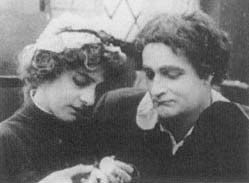
Enoch Arden : Annie gives Enoch the locket.
next shot shows waves crashing against rocks, setting the tone for the performance. Enoch enters, looks back left to establish that he has just exited the previous shot, clenches his fists, makes a downward movement, points to himself, and exits, having decided to confront Philip. This shot illustrates how much more an actor alone in the frame must do to externalize thoughts and emotions, even though the editing pattern and his glance establish his connection with the other characters, making an unchecked histrionic gestural soliloquy unnecessary.
2—
Enoch's Departure
After Many Years shows the couple's misery at parting only through histrionically coded performances featuring extended and redundant gestures. Saying goodbye in long shot on the front porch of their house, the couple embraces, Annie holding the baby. Enoch points to his chest and then upward to the heavens, and raises his hand to his forehead in the classic gesture of despair as he tears himself away from Annie's arms. Turning to leave, he clenches his fists in the air before pausing to lean over the porch railing and kiss Annie once more.
Enoch Arden stages the departure in several shots, with editing, props, and a closer camera reinforcing the couple's emotions. In the first shot (shot 13), Annie, screen left, kneels at a cradle, while her two older children play screen right. Enoch enters the space in the middle of the frame which the composition has left for him, looks at the baby, touches the children, then stands, back to camera, facing the window in the center background. Reaching a decision to leave, he raises his clenched fists to his head and lowers them, engaging in the most histrionically coded gestures of the departure sequence. Enoch signs on, then we see the family in the same composition as before, only this time in close to a medium shot, Enoch and Annie kneeling by the cradle. The next
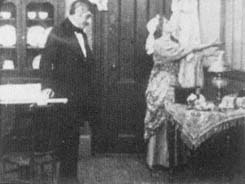
After Many Years : Annie talks to Enoch's portrait.
shot, the closest in the entire film, is a medium close-up of the couple. Annie cuts a curl from the baby's head, puts it in a locket, and hangs it round Enoch's neck, toying with it while speaking to him. As the couple talks, the close camera clearly shows the exchange of sad glances, which the stage business with the locket reinforces. There is no need for histrionically coded gestures here, nor in the shot in which Annie reacts to Enoch's departure.
When Enoch's ship sails away, Annie and the two children stand on the beach, their backs to the camera. Shots of them are intercut with shots of Enoch arriving on board and the ship sailing out of the frame. In the last shot of this beach sequence, Annie and the children stand in three-quarter shot, their backs to the camera, Annie watching the boat through a telescope. She lowers the telescope, takes the children's hands, and shakes her head, all slowly and without great emphasis. The emotional impact of this depends not on the performance alone but on the emotional resonance established by the earlier leave-taking as well as the intercut shots of the departing Enoch.
3—
Annie's Reaction to Enoch's Shipwreck
Both films feature cross-cutting to establish a psychic connection between Annie and her shipwrecked husband, though in the 1908 version Annie already knows of Enoch's misfortune. In the third shot of After Many Years , Annie leans over a crib and Philip enters holding a newspaper that he shows her, shaking his head. Annie conventionally displays feminine distress, placing her hand to her face and backing away from him. Phillip leaves Annie alone to externalize her misery with the aid of two props. Standing in the right background, she holds the newspaper in her fully outstretched arms and talks to a picture, which only repeated viewings have revealed as a portrait of Enoch. Because neither newspaper nor portrait is clearly shown, the histrionically coded performance serves as the
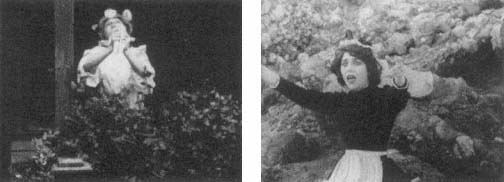
Left: After Many Years : Annie grieves for Enoch. Right: Enoch Arden : Annie grieves for Enoch.
dominant signifier in the shot, at least for a present-day viewer accustomed to the conjunction of narrative significance and compositional centrality.
Later in the film, Griffith for the first time experimented with cross-cutting between characters in different locations to create an emotional link between them.[25] In the eighth shot, Enoch on his island performs a gestural soliloquy of frustration and despair, ending by kissing a locket around his neck. The ninth shot shows Annie in medium close-up, the closest shot of this film, standing on the front porch where she had bid Enoch goodbye. She reaches out her left arm until it is fully extended perpendicular to her body, then her right hand in the same gesture, clasps a handkerchief between both hands and collapses crying. Aside from a rather general indication of loss and despair, the unchecked histrionic gestures here have no intrinsic meaning, gaining their intelligibility only from the conjunction with the previous shot. A more checked degree of the histrionic code might have worked here, but given the relative novelty of the closer camera and the experimental nature of the cross-cutting, it is not strange that the performance is constructed as if it alone revealed Annie's emotions.
In Enoch Arden , Annie reacts in much the same manner. In shot 33 Enoch is washed up on the island. In shot 34 Annie stands on shore facing the camera, then sits down, her back to the camera. Shot 35 returns to Enoch, and in shot 36 Annie realizes Enoch's peril. In medium long shot (the camera now having crossed the line to show her front), she shouts her husband's name, both arms extended outward like the 1908 Annie. Her eyes widen, she shouts again, her body bends forward, she gathers her children to her and looks heavenward. Since this shot constitutes Annie's emotional high point, it follows that the histrionic code, associated in the melodrama with extreme and exces-
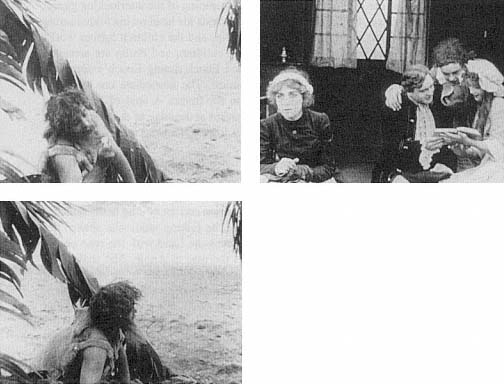
Above left: Enoch Arden: Enoch looks at the locket.
Above right: Enoch Arden: Annie thinks of Enoch.
Lower left: Enoch Arden: Enoch "looks" at Annie.
sive emotion, should be used, even though the repeated intercutting with Enoch closes off the meaning of the performance more than the editing in the 1908 version.[26]
4—
Philip's Proposals
Later in the 1911 film the connection between Annie and Enoch is established through more than performance. After the children have grown up, Philip, whom Annie has already rejected, proposes twice more, to be accepted the second time. The editing in these sequences, coupled with the direction of the characters' glances, fully explains Annie's reluctance, leaving little for the performance to signify. The first proposal is preceded by a shot of a now-bearded Enoch looking at the locket Annie gave him. In the next shot, Annie, the children, and Philip are in Annie's house. After Annie says no to Philip simply by turning her head away, Philip goes to sit with the children, and Annie gazes slightly to the left of the camera. In the next shot, Enoch lies on the beach, looking off right, his gaze almost meeting
Annie's. The use of the prop reinforces the meaning of the interlocking gazes, as Enoch looks at the locket, fingers it, then rests his head on his folded arms. The composition of the shot of Annie, Philip, and the children further works with the editing and the props. Annie, the children, and Philip are arranged precisely as were Annie, the children, and Enoch during Enoch's departure scenes, with Philip now in Enoch's position. The immediate cut to Enoch shows the rightful holder of this place in the frame. A shot of Enoch also precedes the second proposal, as Enoch pauses at the edge of the frame, looks up as if at something offscreen, and then lowers his head in despair. In the following shot Annie accepts Philip.
In After Many Years , Philip proposes twice, with histrionically coded performance and props imparting the necessary information. The first proposal takes place in the garden where Annie and Enoch first appeared, the setting invoking Enoch's absence as do the composition and the editing in the remake. Philip and Annie walk toward the camera, he talking while she shakes her head. They pause, Philip picks a rose, places the hand with the rose on his breast, makes a declaration, and presents the rose to Annie. She shakes her head and pushes the rose away. Her left hand then gestures in the direction of the offscreen house, as if to indicate her continued loyalty to Enoch. Then, with arms fully extended on each side of her body, she shakes her head and walks slowly away, hands at her sides. The rose and Annie's gestures to the house evoke Enoch, but not as directly as the matching glances and intercutting in the later film. Annie's histrionically coded gestures of refusal in After Many Years are necessary because the audience, while reminded of Enoch, never sees him. In the second refusal of the proposal, Annie once more stands before Enoch's portrait, another invocation of his absence. After Philip asks his question, Annie walks to the picture, holds her arms fully extended toward it (in the same gesture she will later use standing on the front porch and reacting to the shipwreck), clasps her hands to her bosom, then once more extends her hands to the picture. Just as in Annie's reaction to the news that Enoch is lost, the prop works with the actor so little that Annie's performance borders on a gestural soliloquy.
5—
Enoch's Locket
In After Many Years , the narrative neither singles out Enoch's portrait nor gives it emotional resonance, hence preventing it from augmenting the actor's performance to any degree. The same holds true of Enoch's locket. In the 1908 film we see the prop for the first time when Enoch, at the end of his gestural soliloquy of frustration and despair, looks at it, then kisses it. Because this is the locket's first appearance, it can serve only as a general symbol: people use lockets to remind them of loved ones from whom they are separated. The 1908 Enoch cannot illustrate his despair simply by looking at the locket. He must raise his hands over his head, clasp them behind
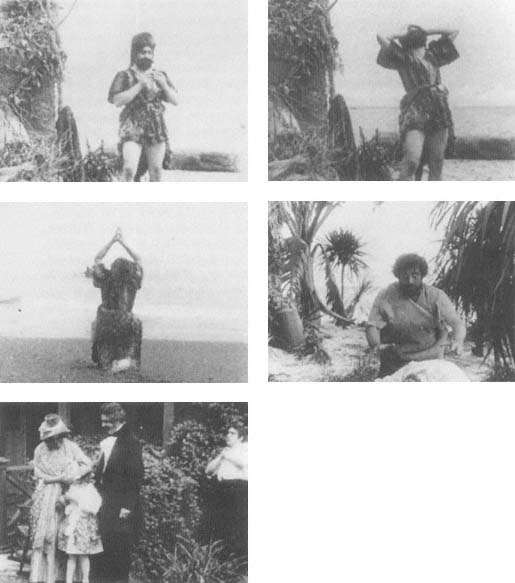
Top left: After Many Years: Enoch looks at the locket.
Top right: After Many Years: Enoch in despair.
Middle left: After Many Years: Enoch appeals to heaven for rescue.
Middle right: Enoch Arden: Enoch grieves for his dead companion.
Lower left: After Many Years: Enoch's homecoming.
his neck, then clench his fists at his sides. The later film shows the locket being given to Enoch, making it a signifier of a particular home and a particular family. The 1911 Enoch can lie quietly on the beach fingering the locket and tell us as much about his emotions as his 1908 counterpart does through gestural soliloquy.
6—
The Histrionically Coded Enoch
Despite the three years that separate the films, when Enoch is placed in circumstances similar to those of the 1908 version, he still, in 1911, uses the histrionic code. In both films, Enoch, awaiting rescue, sees a boat, which the film doesn't show. He must gesticulate wildly, both to attract the imaginary sailors and to convince the audience that the boat is indeed there. In After Many Years , Enoch jumps up and down on the beach waving a blanket, falls to one knee, hands clasped above his head in prayer and pleading, rises, puts hands to his head, staggers back, covers his face in despair, sinks to his knees, hands above head, then collapses full length on the beach.
The 1911 Enoch also uses histrionic gestures, though not in a fully elaborated gestural soliloquy. When this Enoch "sees" the ship, he is lying on the beach looking at the locket. He suddenly rises to his feet, his arms over his head. In the next shot he stands on the beach waving his arms over his head. The 1911 Enoch does perform a gestural soliloquy after the death of his companion, as it is his gestures alone which must externalize his great grief and distress. The man dies cradled in Enoch's arms. Enoch raises the man's head and lets it drop. His hands hover over the body, and his eyes widen. Then he starts back, crawling backwards on his knees. He stands, hands raised as if in surrender, turns, runs, turns again, hands raised. After a cut to Annie, the next shot shows the dead man. Enoch rushes into the shot, makes flailing movements at the body, then rests his head on the man's chest.
7—
Enoch's Return Home
Although After Many Years ends happily, both the 1908 and the 1911 Enochs have scenes in which they enact their dismay and desperation at seeing Philip with their families and assuming the worst. The denouement of After Many Years takes place in the film's last three shots, in all of which Enoch performs at the back or side of the frame unnoticed by the other characters (a theatrical convention of the time). In shot 13 Enoch enters the garden where he had walked with his wife in the film's beginning. He puts down his bundle, extends his left hand to the rose bush, and then kisses a branch, his right hand placed on his chest, his gestures reinforcing the emotional resonance of the setting. Then he looks left, starts back, and staggers back against the bush. Because we do not see what has so affected him, the sudden change in his emotions is momentarily puzzling. The puzzle is resolved when Annie and Philip enter, walk across the frame, and exit. Enoch holds his arms out toward them, sinks to one knee, head lowered, then raises his fists in the air in resolution. In shot 14, Enoch follows Annie and Philip as they walk along the path, clenching his fist in the air and bringing it down forcefully before exiting after them. Shot 15 shows Philip and Annie and the child standing in front of the house, while Enoch stands by a bush in front of the porch. He raises his hands above his head, puts them on his chest, takes
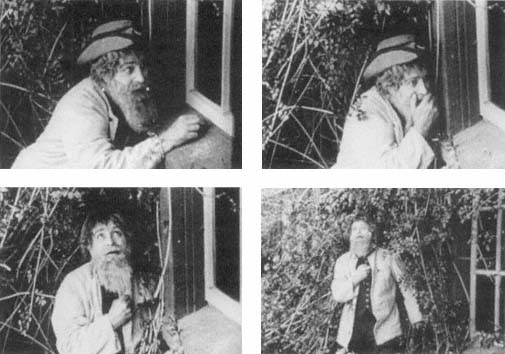
Enoch Arden: Enoch's homecoming.
out a dagger, and pauses as he is about to strike Philip. Annie and Philip go into the house, and Enoch sinks to his knees. Now he begins to interact with the little girl, and then with Annie, who reemerges, but from the time he sees Annie, Philip, and the girl until this point, Enoch's gestures have served as the sole signifiers of his thoughts and emotions and have had to indicate the swift changes in his feelings and intentions.
Compare this with Enoch Arden , in which Enoch's reactions are intercut with the happy family he sees through a window. The film's earlier use of this window has strengthened the poignancy of Enoch's exclusion from home and hearth. Immediately after Enoch's rescue, Annie and Philip are seen outside Philip's house, standing by the window. The next shot shows Enoch homeward bound. In the next shot, Annie, sleeping by the open window, starts awake and, as if in a trance, extends both arms toward the window, then shakes her head and puts her hand to her temple as if coming out of a daze. The reaching gesture, in conjunction with the editing, once again links Annie and Enoch, and in so doing links Enoch and the window. Immediately before
Enoch's appearance outside their house, Annie and Philip stand by the window, and they are shown framed by the window in the next shot, from the exterior. The next shot cuts to the interior, Philip closes the window, shutting out the world, and the family assembles. The very window toward which Annie had reached yearning for her returning husband now serves to separate him from his family, yet gives him an excellent view of all he has lost. The next twelve shots alternate between Enoch outside the house and the family inside.
Let's concentrate on Enoch's reaction shots. The series begins with Enoch in three-quarter shot looking in the window. Shot 78 is a medium shot of Enoch, his eyes widened in reaction, as is shot 80. Not until shot 82 does Enoch say "Annie," cover his mouth, and shrink back. In shot 84 he looks upward, presumably to heaven, and clenches his hand. Shot 85 cuts back to a three-quarter shot in which Enoch staggers back against the shrubbery, his hand on his chest. An intertitle states that Enoch has vowed that Annie will never know of his return, and shot 86 repeats shot 85. Compared to the 1908 Enoch, this Enoch has done very little: the performance is verisimilarly coded, and the editing closes off the meaning.